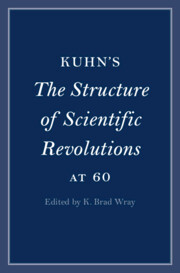Book contents
- Kuhn’s The Structure of Scientific Revolutions at 60
- Cambridge Philosophical Anniversaries
- Kuhn’s The Structure of Scientific Revolutions at 60
- Copyright page
- Dedication
- Contents
- Figures
- Tables
- Contributors
- Acknowledgments
- Abbreviations
- Introduction
- Part I Writing Structure
- Part II Normal Science and Science Education
- 3 Kuhn’s “Fifth Law of Thermodynamics”
- 4 Normal Science
- 5 “Textbook Science” before and after Structure
- 6 Thomas Kuhn, Normal Science, and Education
- Part III Incommensurability, Progress, and Revolutions
- Part IV Kuhn’s Impact on the Philosophy, Sociology, and History of Science
- Bibliography
- Index
3 - Kuhn’s “Fifth Law of Thermodynamics”
Measurement, Data, and Anomalies
from Part II - Normal Science and Science Education
Published online by Cambridge University Press: 05 January 2024
- Kuhn’s The Structure of Scientific Revolutions at 60
- Cambridge Philosophical Anniversaries
- Kuhn’s The Structure of Scientific Revolutions at 60
- Copyright page
- Dedication
- Contents
- Figures
- Tables
- Contributors
- Acknowledgments
- Abbreviations
- Introduction
- Part I Writing Structure
- Part II Normal Science and Science Education
- 3 Kuhn’s “Fifth Law of Thermodynamics”
- 4 Normal Science
- 5 “Textbook Science” before and after Structure
- 6 Thomas Kuhn, Normal Science, and Education
- Part III Incommensurability, Progress, and Revolutions
- Part IV Kuhn’s Impact on the Philosophy, Sociology, and History of Science
- Bibliography
- Index
Summary
This chapter reconstructs Kuhn’s philosophy of measurement and data, paying special attention to what he calls the “fifth law of thermodynamics.” According to this law, there will always be discrepancies between experimental results and scientists’ prior expectations. The history of experiments to determine the values of the fundamental constants offers a striking illustration of Kuhn’s fifth law of thermodynamics, with no experiment giving quite the expected result. The chapter highlights the synergy between Kuhn’s view and the systematic project of iteratively determining the value of physical constants, initiated by spectroscopist Raymond Birge, which was ongoing when Kuhn joined Berkeley in 1956. The analysis sheds light on various underappreciated aspects of Kuhn’s thought, especially his notion of progress as improvement in measurement accuracy.
Keywords
- Type
- Chapter
- Information
- Kuhn's The Structure of Scientific Revolutions at 60 , pp. 55 - 78Publisher: Cambridge University PressPrint publication year: 2024
- 1
- Cited by

